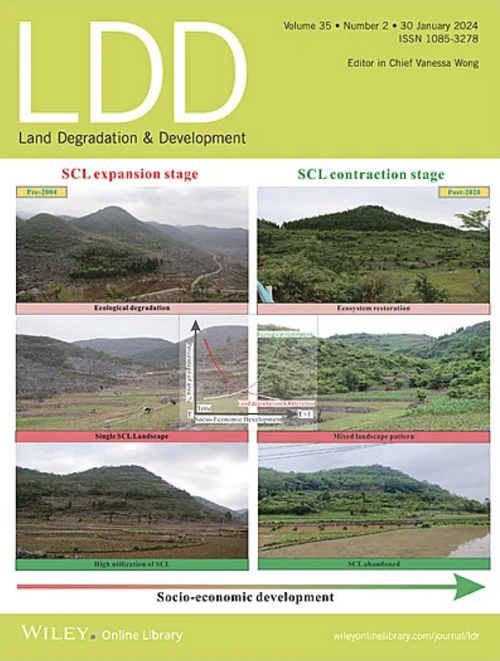IF 3.6
2区 农林科学
Q2 ENVIRONMENTAL SCIENCES
引用次数: 0
摘要
由不同坡位的溶蚀和水土流失作用形成的微生境是中国西南喀斯特地区石漠化的表现形式。微生境通过影响土壤和植被的性质以及土壤的可侵蚀性,改变土壤水文过程和土壤侵蚀过程,在喀斯特地貌的生态恢复中发挥着重要作用。然而,很少有研究探讨微生境类型和坡位对土壤侵蚀性的潜在影响。因此,本研究评估了两种坡位(上坡和下坡)和四种微生境类型(岩坑、岩缝、岩土表面和土壤表面)下土壤内聚力(Coh)、K因子(K)、渗透阻力(PR)、土壤结构稳定性指数(SSI)、饱和导水率(Ks)和土壤侵蚀综合指数(CSEI)等土壤侵蚀性指标的变化。结果表明,土壤侵蚀性指标 Coh、SSI、Ks、K 和 PR 随微生境类型和坡度位置的变化而显著不同。此外,坡上和坡下的 CSEI 分别为 0.45 至 0.77 和 0.25 至 0.67。不过,在两个坡位上,岩土表面微生境的 CSEI 最大,而岩坑微生境的 CSEI 最小。此外,上坡位不同微生境类型的平均 CSEI 显著高于下坡位,表明岩溶地区上坡位更容易受到侵蚀。这些不同微生境类型和坡位之间 CSEI 的变化都是受其对土壤和植被特性的影响所控制的。然而,在这两个坡位之间,微生境类型对 CSEI 的影响机制完全不同。上坡位不同微生境类型的 CSEI 变化主要受植物枯落物促进土壤结构的间接效应控制,而下坡位的 CSEI 变化则受植物根系结合和粘结的直接效应调控。这些结果对深入理解不同微生境类型和坡位下土壤侵蚀性空间变化的影响机制,特别是上坡位岩石土面对土壤侵蚀性的影响具有重要意义。应高度重视针对岩土面及上坡位微生境的生物措施,如培育特殊的生物土壤外壳,以防止区域性水土流失,改善西南岩溶地区的环境质量。抗水土流失;微生境;坡上坡下;土壤和植被特性;岩溶地区。本文章由计算机程序翻译,如有差异,请以英文原文为准。
Variations in Soil Erodibility Induced by Microhabitat Types and Slope Positions in the Karst Region of Southwest China
Microhabitats, caused by the action of dissolution and soil erosion at different slope positions, are manifestations of rocky desertification in Karst areas of Southwest China. They play a significant role in the ecological restoration of the karst landscape by changing soil hydrological and soil erosion processes via affecting soil and vegetation properties as well as soil erodibility. Nevertheless, few studies have been conducted to investigate the potential influences of microhabitat types and slope positions on soil erodibility. Thus, this study was performed to assess the variations in soil erodibility indicators described by the soil cohesion (Coh), K factor (K), penetration resistance (PR), soil structural stability index (SSI), saturated hydraulic conductivity (Ks), and a comprehensive soil erodibility index (CSEI) at two slope positions (upper and lower) and four microhabitat types (rock pit, rock crevice, rocky soil surface, and soil surface). The results indicated that soil erodibility indicators of Coh, SSI, Ks, K, and PR varied significantly with microhabitat types and slope positions. Furthermore, CSEI varied from 0.45 to 0.77 and from 0.25 to 0.67 for the upper and lower slope positions, respectively. However, the microhabitat of rocky soil surface had the maximum CSEI, whereas the microhabitat of rock pit had the minimum CSEI for both slope positions. Furthermore, the mean CSEI among different microhabitat types of the upper position was dramatically greater than that of the lower position, indicating that the upper slope position was more prone to erosion in the karst region. All these variations in CSEI between different microhabitat types and slope positions were controlled by their influence on soil and vegetation properties. However, the influencing mechanism of microhabitat types on CSEI was completely different between these two slope positions. Changes in CSEI in different microhabitat types of the upper slope position were mainly controlled by the indirect effect of plant litter in promoting soil structure, whereas those for the lower slope position were regulated by the direct effect of plant root binding and bonding. These results have crucial implications for deeply comprehending the impacting mechanism of the spatial changes in soil erodibility under different microhabitat types and slope positions, particularly the impacts of rocky soil surface in the upper slope position on soil erodibility. Great attention should be paid to deploying biological measures for the microhabitat of rocky soil surface and the upper slope position, such as the cultivating of special biological soil crust, to prevent regional soil erosion and improve the environmental quality in karst areas of Southwest China. Soil erosion resistance; Microhabitats; Upper and lower slope positions; Soil and vegetation properties; Karst areas.
求助全文
通过发布文献求助,成功后即可免费获取论文全文。
去求助
来源期刊

Land Degradation & Development
农林科学-环境科学
CiteScore
7.70
自引率
8.50%
发文量
379
审稿时长
5.5 months
期刊介绍:
Land Degradation & Development is an international journal which seeks to promote rational study of the recognition, monitoring, control and rehabilitation of degradation in terrestrial environments. The journal focuses on:
- what land degradation is;
- what causes land degradation;
- the impacts of land degradation
- the scale of land degradation;
- the history, current status or future trends of land degradation;
- avoidance, mitigation and control of land degradation;
- remedial actions to rehabilitate or restore degraded land;
- sustainable land management.
 求助内容:
求助内容: 应助结果提醒方式:
应助结果提醒方式:


